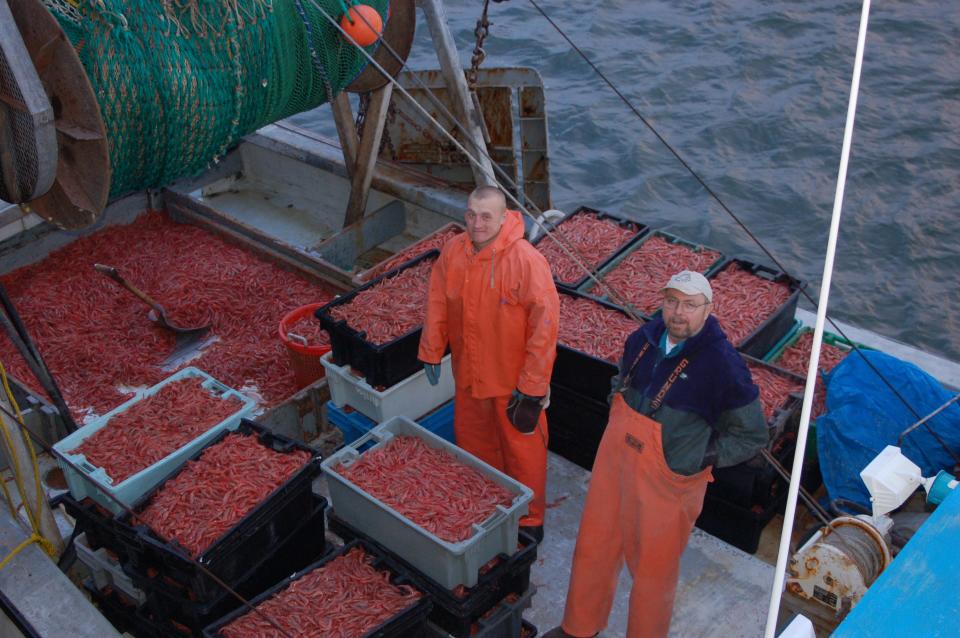How warming ocean temperatures wiped out Maine’s shrimp industry
Shrimp is one of the iconic New England meals.
Unfortunately, Gulf of Maine shrimp or northern shrimp (Pandalus borealis) are a cold-water species and New England is on the very southern tip of their range.
They occur from the Arctic to northern New England and are one species that is so temperature-dependent that we could use them as an indicator to detect climate changes.
Since 2014 fishing for northern shrimp has been banned in the United States. The stock in our area has decreased to the point where they are not reproducing. This is not due to overfishing; it is directly due to the temperature of the water. They have simply moved north to colder Canadian waters.

Let’s have a short biology lesson on northern shrimp. Shrimp are a crustacean, related to lobsters and crabs. Like other crustaceans, they have an exoskeleton and must molt to grow. They are pink/red and have fin-like pleopods under their tail which allow them to dart swiftly away from predators and swim long distances.
Atlantic sturgeon: Endangered ‘prehistoric-looking’ fish spotted near Hampton Harbor
As a matter of fact, these small animals are diurnal; they spend the night mid-water and sink to the bottom during the day following their food, plankton, that does the same. They also spend the summer in the deep water of the central Gulf of Maine basins where they shed and migrate to the inshore during the winter where they spawn.
This allows the eggs to hatch in an area of high plankton count so the larvae have food to eat. Northern shrimp will spawn only at around 2-3 degrees Celsius.
Thus, the warming of the Gulf of Maine has not allowed for a successful spawn in many years. For the past few years, the inshore here has averaged 4-6 degrees Celsius.
Northern shrimp grow to about 3-4 inches and live along the muddy bottom and inhabit the middle of the food chain in the Gulf of Maine. They eat plankton both plant and animal and in turn are eaten by cod, spiny dogfish sharks, whiting and other important food fish.
Decorator crabs: The amazing spider crustaceans found in Hampton Beach tidepools
This is where it becomes interesting. Shrimp are short-lived crustaceans usually living only five years. They hatch out of eggs and mature at about 2 ½ years as males at which time they spawn. Then at about 3 ½ they begin transitioning into a female and live for another two years.
Their entire lifespan is around five years. Bizarre but true.
Back in 2007, when there was a robust northern shrimp fishery in the Gulf of Maine, scientists were looking for net modifications that would catch shrimp but not have any bycatch of finfish. Since shrimp fisheries throughout the world have some of the highest bycatch of any fishery, this was a priority worldwide.
At that time the Northeast Consortium at the University of New Hampshire helped fund research by Dr. Pingguo. He and David Goethel developed a trawl net, named “The Topless Trawl,” that drastically reduced bycatch in the northern shrimp fishery. It proved so effective at reducing the bycatch that it earned an honorable mention from the World Wildlife Fund’s “Smart Gear” competition. It also helped local fishermen preserve groundfish stocks while fishing for shrimp. The crew loved the net as all they had to do was shovel the shrimp into boxes to sell, and the shrimp catch increased. An easy day on the ocean for them. Although they are no longer fishing for shrimp in the U.S., the net has continued to be modified by the Canadians.

Now you may say, wait, I’ve seen baby shrimp in the tidepools! You may have seen what looks like a shrimp either an amphipod or even an invader to our shores, a European rockpool shrimp (Palaemon elegans). While amphipods are abundant and look like baby shrimp, their adult size can be under an inch and their life span is very short.
Recently, I have been spotting some very shrimp-like animals about 2 inches in length. They are the rockpool shrimp, another invasive species recently arrived from Europe, first spotted in the Gulf of Maine in 2010. These seem to be doing very well and may cause some disturbance in the estuarian food chain. Time will tell. In this day of rapid movement by ships all over the world, we will inevitably be seeing more and more invasives. While these invasives can change the ecosystem permanently it is also how evolution continues. In the ocean, evolution seems to be occurring more and more rapidly.
Keep your eyes open when hunting the tidepools, focus on these tiny animals, you may be amazed at how many different ones you will see.
Ellen Goethel is a marine biologist and the owner of Explore the Ocean World at 367 Ocean Blvd. at Hampton Beach.
This article originally appeared on Portsmouth Herald: Northern shrimp: Here's why you can't fish for them in Gulf of Maine

